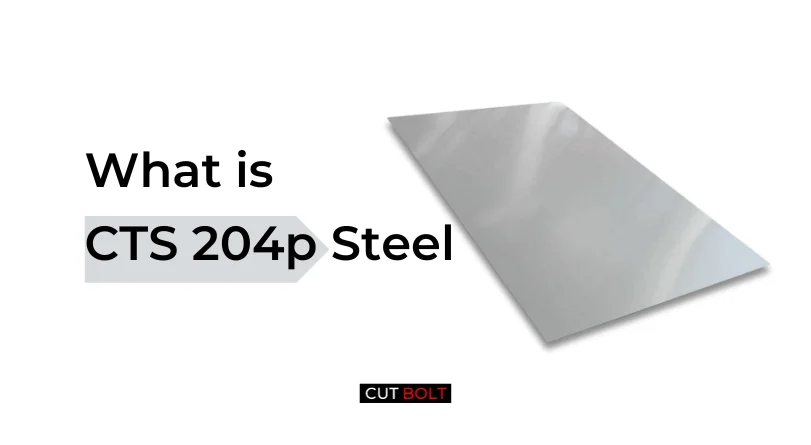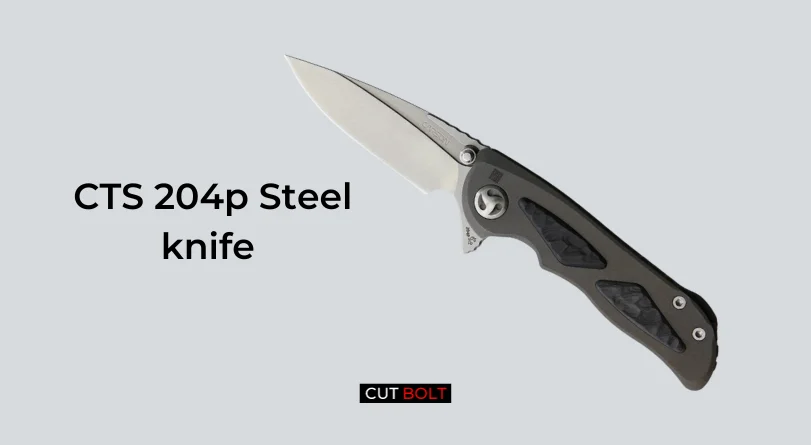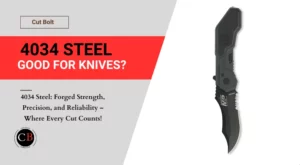Today we are presenting our CTS 204P steel review.
If you’re a budding knife enthusiast, chances are you’ve studied premium knives, what they’re made of, and you’ve heard of CTS 204P steel. Chances are you’ve also noticed that a wide variety of materials and tempering methods are used to make knife blades, so getting started in the world of knives can be pretty tough.
Well, it was the same for me, and to make it easier to get started with CTS 204P, I researched this knife steel and put together the information I could find about it in this article. In the following article, I will go over the main properties and characteristics such as its chemical composition, hardness, suitability as a knife steel, and so on.
First of all, let’s clarify the question:
What is CTS 204P steel?
CTS-204P is the Carpenter equivalent of Böhler M390 steel as well as 20CV steel from and Crucible Industries, but with slightly more tungsten than in the other two.
As for the powder metallurgy manufacturing process, it should produce a powder as fine as Böhler-Uddeholm’s 3rd generation process. In other words, the generation numbers are specific to the particular steelmaker and not directly comparable.
CTS-204P has very high corrosion and wear resistance. In this regard, the fine-grained alloy is a popular choice for premium folding knives and small fixed blades.
Table of Contents
Other designations and standards CTS 204P steel known as:
CTS 204P steel is also known under its alias (CARPENTER) Micro-Melt 20-4p furthermore it is also available under these proprietary designations:
- Böhler-Uddeholm M390
- Böhler-Uddeholm M390 Isomatrix
- Böhler-Uddeholm M390 MicroClean
- Latrobe 20CV
- Latrobe CPM 20CV
- Latrobe DuraTech 20CV

Chemical composition of CTS 204P steel
| Element | Portion | Effect |
| Chrome | 20.0% | Improves wear resistance, heat resistance and scale resistance. It increases tensile strength because it acts as a carbide former. Use of rust-proof or stainless steel, as it increases corrosion resistance from a mass proportion of 12.2%. Reduction in weldability. |
| Carbon | 1.9% | Increasing hardness and tensile strength. In larger quantities, increase in brittleness and reduction in forgeability and weldability. |
| Manganese | 0.35% | Improves hardness and tensile strength. |
| Molybdenum | 1.0% | Improves hardenability, tensile strength and weldability. Reduction in forgeability and ductility. |
| Silicon | 0.6% | Improves strength. |
| Vanadium | 4.0% | Increasing hardness, increasing wear resistance and improving tempering resistance. |
| Tungsten | 0.65% | Increase in heat strength, tempering resistance and wear resistance at high temperatures up to red heat. |
What is the hardness (HRC) of CTS 204P steel?
CTS 204P can achieve a working hardness of 62HRC with excellent performance on both rough and highly polished cutting edges. However, it still takes you about 15° per cutting edge side to get the best performance and edge retention.
There is a problem of the thin cutting edge not being able to support all the carbides needed for its performance.
Is CTS 204P rust-free or stainless steel?
CTS 204P steel is both a stainless steel and a stainless steel. To be considered rustproof it must contain a minimum of 10.5 – 13% chromium, depending on the definition, dissolved in the austenite or ferrite. CTS 204P contains 20%, so more than enough. And it is also a stainless steel, since its sulfur and phosphorus content (so-called iron companion) does not exceed 0.025%. CTS 204P does not contain either element.
Properties of CTS 204P steel
According to the chemical composition and hardness of CTS 204P steel, it offers the following properties and characteristics:
Edge retention: CTS 204P has a high content of vanadium and carbon, which provides great hardness and good cut resistance.
Corrosion resistance: CTS 204P has excellent corrosion resistance due to its high chromium content (20%).
Wear resistance: The wear resistance of CTS 204P is excellent due to the high vanadium and chromium content.
Sharpness: The rule of thumb is “the harder the steel, the harder it is to sharpen”. Therefore, sharpening CTS 204P is a challenging task that is rather frustrating with conventional watered grindstones. There is no getting around diamond whetstones when “hand sharpening” from a hardness of 60. The flip side of the coin is that once sharp, a knife does not need to be resharpened for a very long time. Furthermore, it is worth mentioning that no stubborn burr is formed during sharpening.
Toughness: the toughness of CTS 204P, despite being a hard knife, is good. It is not brittle and offers a good balance between hardness, corrosion resistance and toughness.
Is CTS 204P a good knife steel?
The short version? Yes, CTS 204P is a very tough and hard steel that makes an excellent knife steel.
In fact, the only drawback to this material is that it is difficult to sharpen. However, once sharpened, it keeps its sharpness for a very long time, so this doesn’t have to be done too often!

Other steels that are equivalents to CTS 204P steel
CTS 204P is a premium stainless steel that offers high performance. The two steels that come closest to it are Böhler-Uddeholm’s M390 and Crucible’s CPM 20CV. Both are premium steels with similar chemical composition (CTS 204P contains slightly more tungsten compared to M390 and CPM 20CV – 0.65% instead of 0.6%). Both steels are also used to make high quality premium knives, and all three steels are nearly identical in their properties and characteristics.
CTS 204P vs Steel
Let’s put the CTS 204P M390, 20CV and two other premium steels head-to-head in four criteria: edge retention, corrosion resistance, ease of sharpening and toughness, on a scale of 1 to 10:
M390 offers the same performance as CTS 204P in terms of edge retention, toughness and corrosion resistance.
| Discipline | CTS 204P | CPM 20CV |
| Edge retention | 8/10 | 8/10 |
| Simplicity of sharpening | 5/10 | 5/10 |
| Corrosion resistance | 8/10 | 8/10 |
| Toughness | 6/10 | 6/10 |
CPM 20CV also offers the same performance as CTS 204P in terms of edge retention, toughness and corrosion resistance.
| Discipline | CTS 204P | ELMAX |
| Edge retention | 8/10 | 7/10 |
| Simplicity of sharpening | 5/10 | 5/10 |
| Corrosion resistance | 8/10 | 7/10 |
| Toughness | 6/10 | 7/10 |
Compared to CTS 204P, ELMAX offers slightly lower edge retention, lower corrosion resistance but slightly more toughness.
| Discipline | CTS 204P | CPM S35VN |
| Edge retention | 8/10 | 6/10 |
| Simplicity of sharpening | 5/10 | 6/10 |
| Corrosion resistance | 8/10 | 710 |
| Toughness | 6/10 | 6/10 |
Compared to CTS 204P, S35VN offers slightly lower edge retention and lower corrosion resistance but roughly the same toughness.
Conclusion: CTS 204p steel review
If you are a knife maker or knife user, you should know which steel your knife is made of. For every new knife we should choose according to our need.
Yes, we always strive for the best steel for our knife such as CTS 204P. CTS 204P is considered a premium steel.
Now the question is do we need premium knife steel?
The answer can be both yes and no. Premium steel gives you premium knife experience. But a normal knife can do the same job. The difference is premium knife would not require frequent sharpening, while a normal knife will require frequent sharpening and more care.
At the end of CTS 204p steel review, I would recommend choosing a knife within your budget.



